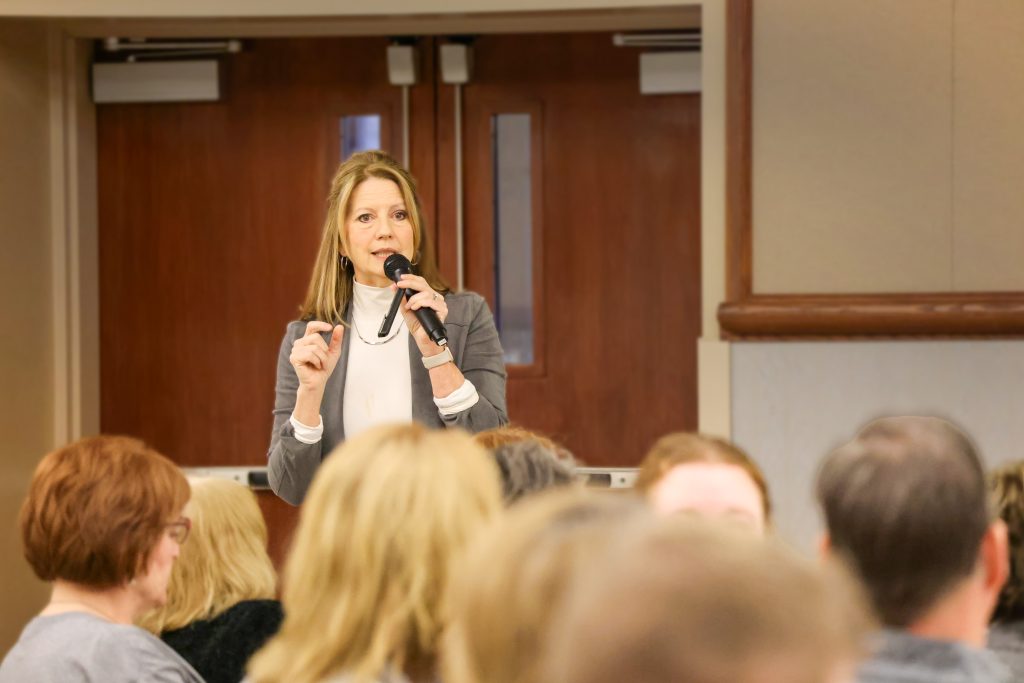Visible Learning program empowers educators to illuminate student growth

As part of the One Family, Fully Alive in Christ! Campaign, our commitment to strong and vibrant Catholic schools starts with a renewed commitment to our Catholic educators. To assist with recruiting and retaining the best candidates for our Catholic schools, 38 new school-based endowments will be established to supplement teachers’ salaries in every school across the diocese. To learn more about the Fully Alive! Campaign, please visit www.OneFamilyFullyAlive.org.
It’s easy to see the benefits of Visible Learning, according to Janet Eaton, the superintendent of Catholic Schools.
Visible Learning is based on research developed in part by Professor John Hattie of the University of Melbourne, Australia.
“John Hattie has so much to offer our teachers,” she said. “As we came out of Covid it seemed like the right decision to look at his research and adopt this mindset, and now three years later, I’m convinced that we are moving the needle and our teachers are being exposed to outstanding professional development in all of our schools.”
Single school struggle to
offer professional development
She said she knows as a former principal how difficult it is for a single school to offer professional development from experts like John Hattie. “Bringing everyone together for this effort has made it all possible.”
Eaton credited Associate Superintendent Jamie Finkeldei with his vision of how Visible Learning would help the office achieve a long-range goal of helping Catholic school teachers. “We are doing this because we owe it to our educators to not only feed them spiritually but to also feed them in their professional lives,” Eaton said.
Finkeldei said Visible Learning helps create a common language among all of the professionals and teachers.
“This allows collaboration between schools that was previously unprecedented. It’s a long-term commitment,” he said. “We know professional development shouldn’t be one-and-done. We’ve offered a lot of great professional development classes but they’ve been one and done. To sustain something over a five-year period can really ingrain it into the culture of the schools in the diocese.”
Finkeldei said three years into Visible Learning, Catholic school teachers understand that the office is committed to it, committed to a change in culture, and know it’s not a flash in the pan.
Three years into the program
Three levels of training have been nurtured over the past three years, he said. There has been leadership training at every school and leadership teams have created goals for their schools.
“As much as this is a diocesan-led project,” he said, “every school is different and is going to implement it a little differently.”
Visible Learning involves all-teacher training and specific training for impact coaches and various teacher teams. “So for people who are ready to go further or ready to support their fellow teachers, we have additional training for them as well,” Finkeldei said.
Hattie is well-known in education and has extensively researched different teaching strategies, he added. “As he always says, every strategy helps kids learn…but what strategies have the most impact, what strategies work best – he has done that research. By trying to convey that to our teachers, in a time of limited resources and the limited time that you have to teach in the class, the more you can maximize the most effective strategies, the better off you’ll be.”
Here are comments about Visible Learning written by some of the Catholic school principals:
Stephanie Warren
St. Thomas Aquinas Catholic School
“Having all of our schools focused on the same professional development has given our teachers the opportunity to collaborate in a whole new way. We are consistently sharing ideas and resources and helping support our fellow educators. We are all invested and working together to help ensure the success of each school in the diocese.”
Tim Conrad
St. Mary’s Colgan Catholic High School
“Visible Learning has increased student focus regarding the main objective(s) of the particular class. It has made learning more intentional and empowers students to understand exactly what skills they will be held accountable for during the learning process. It also has enhanced opportunities for student feedback for teachers to adjust instruction to meet the needs of student learning.”
Chris Bloomer
Kapaun Mt. Carmel Catholic High School
“Visible Learning has made our students much more aware and responsible for their learning. Whether it be the daily lesson or preparation for a project or test, they have a better sense of what they are trying to accomplish. This is very important in the content-rich environment of high school where it’s easy to be overwhelmed with the flood of new information and skills.”
Peggy Bahr
St. Joseph Catholic School, McPherson
“Having all schools focused on the one priority of Visible Learning has been a giant step towards helping our schools work together for the common goal of school improvement. It has allowed all of our schools, whether they are a Drexel, a rural, or a suburban school, to have a common language and toolbox for quality instruction that points teachers toward instructional strategies that research has shown to be effective across subject and grade levels. It has brought teachers together from varying schools to dialogue about best instructional practices, and has given them the opportunity to learn from each other, as they are the true experts in the classroom.”
Erin Hohl
St. Joseph Catholic School, Ost
“Our teachers are being much more explicit in communicating and sharing what students should expect and learn each and every day. By doing this, the students have a roadmap for their learning experience and are better able to monitor their own progress.”
